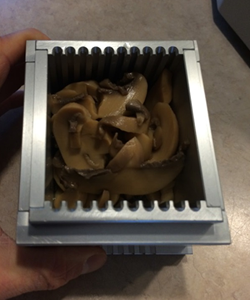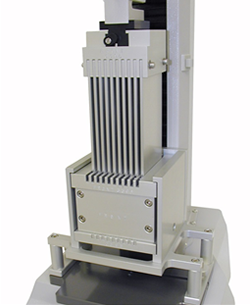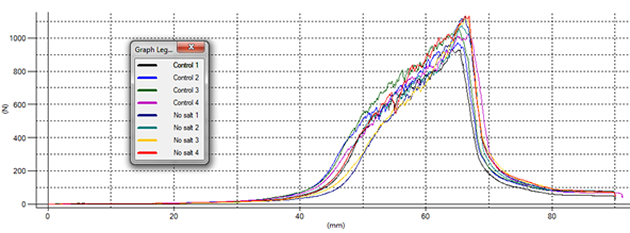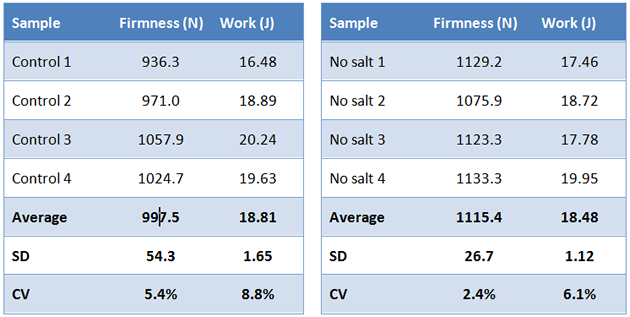Texture Analysis SolutionsMushrooms (Canned) Firmness Effect of Salt
Highlights
- Alternative formulations correlated to the physical properites of the canned product
- Repeatable test method for comparative results using a software-controlled texture analyzer
- Industry-standard bulk compression-shear fixture to accurately replicate bite and chew effort
- Quantified hardness texture profile to verify processing additives have minimal impact on customer acceptance
Situation
 A producer of canned mushrooms uses simple subjective measurements to evaluate the final texture of their product. The information is often used to make adjustments to the process. Their real need, however, is to obtain objective data that represents the sensory evaluation. Our example here demonstrates how this can easily be done using a food texture analyzer. For the particular test, an unsalted (control) product and a low-salt equivalent were compared.
A producer of canned mushrooms uses simple subjective measurements to evaluate the final texture of their product. The information is often used to make adjustments to the process. Their real need, however, is to obtain objective data that represents the sensory evaluation. Our example here demonstrates how this can easily be done using a food texture analyzer. For the particular test, an unsalted (control) product and a low-salt equivalent were compared.
Method
 A Food Technology Corporation (FTC) TMS-Pro Texture Analyzer was fitted with a 2.5 kN intelligent loadcell, along with a Kramer shear compression cell. This type of test cell is designed for testing products in a bulk form instead of small samples, compressing and extruding the contents with multiple blades. This method of testing generally produces more consistent results than simple probe or plate compression, achieving average texture values across the bulk sample. Each test used a whole can of drained mushrooms, which was allowed to stand for 90 seconds before being added to the shear cell.
A Food Technology Corporation (FTC) TMS-Pro Texture Analyzer was fitted with a 2.5 kN intelligent loadcell, along with a Kramer shear compression cell. This type of test cell is designed for testing products in a bulk form instead of small samples, compressing and extruding the contents with multiple blades. This method of testing generally produces more consistent results than simple probe or plate compression, achieving average texture values across the bulk sample. Each test used a whole can of drained mushrooms, which was allowed to stand for 90 seconds before being added to the shear cell.
The TL-Pro control and analysis software was programmed to move the blades of the test cell down at a speed of 250 mm/min to a distance far enough to ensure that the product was completely expressed through the bottom of the test cell. On completion of the test cycle, the software automatically calculated the peak force of compression or ‘firmness’ of the sample. In addition, the work done (energy spent, or area under the curve) was calculated as an additional defining factor.
Results

The graphical representation from TL-Pro, of the test results for the four samples, is shown here (force applied, against cumulative displacement).
The control and salted samples show no great distinction, there being no clear division of groups of traces. Lines cross, but generally with a greater peak force found in the unsalted samples, showing that firmness can increase at greater compression and extrusion depending on the product formulation.
The same results with additional calculations are shown here.
- Average = arithmetic mean
- SD = standard deviation
- CV = coefficient of variation: (SD/Mean) x 100
Significance

Consistency in the results demonstrates that this method of testing is reliable, repeatable and detailed. Peak values over bulk testing are a valid and useful comparison. Firmness in itself may, however, be variable across the test, since shear is taking place, not just compression. The energy expended in completing the cycle could provide a more useful comparison figure, as may firmness at specific displacements. What we have demonstrated, however, is that objective and detailed data are available with computerized texture analysis that cannot be obtained any other way. These data provide an invaluable way to compare product formulations against subjective evaluations of what is a desired texture experience, and then to automate testing for acceptability.
